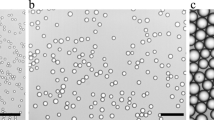Abstract
Our objective was to study the influence of droplet composition on the rate of lipid oxidation in emulsions. A series of oil-in-water emulsions stabilized by a nonionic surfactant (Tween 20) was studied. These emulsions had the same total oil concentration (5 wt%) and initial droplet diameter (0.3 μm), but contained droplets with different ratios of ethyl linoleate (substrate) andn-tetradecane (inert diluent). Lipid oxidation was measured as a function of time by three different methods: gas-chromatographic determination of residual substrate; ultraviolet-visible spectrophotometric determination of conjugated dienes; and measurement of aqueous thiobarbituric acid-reactive substances. All three methods showed similar trends for emulsions of similar composition. The progress of lipid oxidation in the emulsions was dependent on the concentration of ethyl linoleate in the emulsion droplets. At low concentrations (1% oil as substrate), oxidation proceeded at a relatively slow and constant rate. At intermediate concentrations (20%), the oxidation rate was rapid initially and then slowed down with time. At high concentrations (100%), the oxidation rate was slow at first, and then increased with time. An explanation of our results is proposed in terms of the distribution of substrate molecules between the droplet interior and interface, and the ingress of aqueous radicals into the emulsion droplets.
Similar content being viewed by others
References
Alexander, J.C., Biological Effects in Fats Due to Heating,J. Am. Oil Chem. Soc. 42:711–717 (1978).
Artman, N.R., The Chemical and Biological Properties of Heated and Oxidised Fats,Adv. Lipids Res. 7:245–330 (1969).
Halliwell, B., and J.M.C. Gutteridge,Free Radicals in Biology and Medicine, 2nd edn., Clarendon Press, Oxford, 1991.
Allen, J.C., and R.J. Hamilton (eds.),Rancidity in Foods, Applied Science Publishers, New York, 1983.
Nawar, W.W., Lipids, inFood Chemistry, edited by. O.R. Fenema, 3rd edn., Marcel Dekker, Inc., New York, 1996, pp. 226–319.
Labuza, T., Kinetics of Lipid Oxidation in Foods,CRC Crit. Rev. Food Tech. 2:355–405 (1971).
Halliwell, B., M.A. Murcia, S. Chirico, and O.I. Aruoma, Free Radicals and Antioxidants in Food andin vivo: What They Do and How They Work,Crit. Rev. Food. Sci. Nutr. 35:7–20 (1995).
Coupland, J.N., and D.J. McClements, Lipid Oxidation in Food Emulsions,Trends Food Sci. Technol. 7:83–91 (1996).
Pryor, W.A., T. Strickland, and D.F. Church, Comparison of the Efficiencies of Several Natural and Synthetic Antioxidants in Aqueous Sodium Dodecyl Sulphate Micelle Solutions,J. Am. Chem. Soc. 110:2224–2229 (1988).
Motoyama, T., M. Miki, M. Mino, M. Takahashi, and E. Niki, Synergistic Inhibition of Oxidation in Dispersed Phosphatidylcholine Liposomes by a Combination of Vitamin E and Cysteine,Arch. Biochem. Biophys. 270:655–661 (1989).
Dickinson, E., and G. Stainsby,Colloids in Food, Applied Science, London, 1982, pp. 1–20.
Marcuse, R., and P.O. Fredriksson, Fat Oxidation at Low Oxygen Pressure. I. Kinetic Studies on the Rate of Fat Oxidation in Emulsions,J. Am. Oil Chem. Soc. 45:400–407 (1968).
Marcuse, R., and P.O. Fredriksson, Fat Oxidation at Low Oxygen Pressure. II. Kinetic Studies on Linoleic Acid Oxidation in Emulsions in the Presence of Antioxidants,46:262–268 (1968).
Porter, W.L., Paradoxical Behavior of Antioxidants in Food and Biological Systems,Tox. Ind. Health 9:93–122 (1993).
Frankel, E.N., S.W. Huang, J. Kanner, and J.B. German, Interfacial Phenomena in the Evaluation of Antioxidants: Bulk Oils vs. Emulsions,J. Agric. Food Chem. 42:1054–1059 (1994).
Sims, R.J., J.A. Fioriti, and J. Tumbetas, Effect of Sugars and Sugar Alcohols on Autoxidation of Safflower Oil in Emulsions,J. Am. Chem. Soc. 56:742–745 (1979).
Barclay, L.R.C., S.J. Locke, and J.M. MacNeil, The Autoxidation of Unsaturated Lipids in Micelles. Synergism of Inhibitors Vitamins C and E,Can. J. Chem. 61:1288–1290 (1983).
Roozen, J.P., E.N. Frankel, and J.E. Kinsella, Enzymic and Autoxidation of Lipids in Low Fat Foods: Model of Linoleic Acid in Emulsified Hexadecane,Food Chem. 50:33–38 (1994).
Roozen, J.P., E.N. Frankel, and J.E. Kinsella, Enzymic and Autoxidation of Lipids in Low-Fat Foods: Model of Linoleic Acid in Emulsified Triolein and Vegetable Oils,50:39–43 (1994).
Israelachvilli, J.N.,Intermolecular and Surface Forces, Academic Press, New York, 1992.
Hiemenz, P.C., Principles of Colloid and Surface Chemistry, 2nd edn., Marcel Dekker Inc., New York, 1986, pp. 363–373.
Ke, P.J., and R.G. Ackman, Bunsen Coefficient for Oxygen in Marine Oils at Various Temperatures Determined by an Exponential Dilution Method with a Polarographic Oxygen Electrode,J. Am. Oil. Chem. Soc. 50:429–435 (1973).
Author information
Authors and Affiliations
About this article
Cite this article
Coupland, J.N., Zhu, Z., Wan, H. et al. Droplet composition affects the rate of oxidation of emulsified ethyl linoleate. J Am Oil Chem Soc 73, 795–801 (1996). https://doi.org/10.1007/BF02517957
Received:
Accepted:
Issue Date:
DOI: https://doi.org/10.1007/BF02517957




